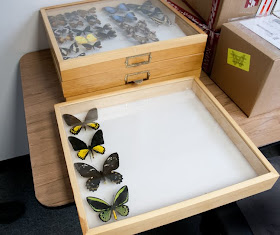
Last year, Life Sciences Volunteer Terry Pagos went to Colorado and visited one of our pupae suppliers, Rich Cowan, at LPS LLC (formerly London Pupae Supply). This import facility handles most butterfly pupae brought into the USA, sorting them for quality before sending them onto their final destinations. While there, Terry became fascinated with the beautiful birdwing butterflies. Too bad for Terry. Pacific Science Center did not have this species on its permit at the time.
It took many long months and a very fussy application before we were given USDA permission to fly birdwing butterflies, but at long last, they are arriving.

Last week in our LPS shipment, we received five pupae of the species, Ornithoptera priamus. These huge relatives of the more familiar swallowtail butterflies are found in parts of Australia, New Guinea, and Southeast Asia. They are not only large, but striking. Their wings are brilliant green and yellow on a black background. They also have unusual, bright yellow abdomens, and a single deep red spot on each side of the thorax.

Best of all, they are not at all shy. Because their larvae feed on the toxic plants of the Aristolochia family, these butterflies taste bad to predators, and they seem to know it. Their flight is slow and relaxed. They calmly feed mere inches from the fascinated viewer. The birdwing has an astounding wingspan of 18 cm, over 7 inches! We speak the truth when we say, this butterfly can only be appreciated in person.

The birdwings will take a few weeks to emerge, so we can’t predict exactly when they will be out for viewing, but we guarantee when you see them you will be impressed. Visiting gaudy, heat-loving butterflies in a fragrant, warm habitat is a great way to usher in the darkest days of the year. Stop by and visit!
I volunteer at the Peggy Notebaert Nature Museum in Chicago, and these are some of the most beautiful butterflies we have in our butterfly haven. (And either fascinating or horrifying, depending on your view of such natural processes: They're the ones most frequently spotted mating, and the process can last for several hours.)
ReplyDelete